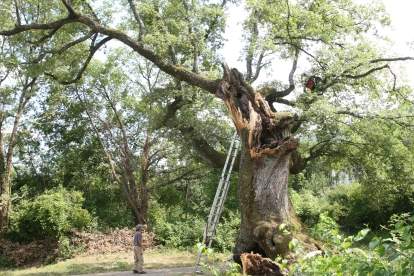
REPAIR OF DAMAGED OLD OAK TREE AT SV. PETAR ON CRES ISLAND
After windy and stormy weather caused severe damage to the crown of the protected, old oak tree at Sv. Petar, it became necessary to repair this protected natural monument, because of the serious threat of other parts of the crown and other branches breaking off. Although the
Protection Measures for this valued natural monument explicitly state that the old tree should be “left to the natural processes of growth, aging and death” (the reason for this is biodiversity conservation, because old trees are small eco-systems in themselves, with a multitude of associated
insects, fungi, birds and other organisation linked to such trees!), the tree was assessed to present a direct threat to the safety of people and property that might come into the vicinity of the damaged tree. In such a case, the Protect Measures prescribe repair.
Under the organisation of the Public Institution “Priroda”, repair work on the oak tree was carried out on 18 June 2007. To provide readers with complete information, below is the full report that Mr. Viktor Lochert of the “Stablosan” company submitted to the
Public Institution upon completion of work. At earlier times, Mr. Lochert had examined the tree using modern methods (instruments for assessing the health condition of the tree – resistography), and he was present at and guided the course of repair to the damaged tree.
“During a storm on 27 May 2007, a strong gust of wind broke a substantial part of the crown of this centuries-old oak tree. The remaining part of the crown was one-sided, tall and thick, forming a tall “sail” that another similarly strong gust of wind might easily
catch and break off. Were this to happen, the oak tree would lose its entire assimilation apparatus and it would be sentenced to a quick death. Namely, to survive, every tree throughout its lifetime seeks to create the best possible ratio of crown (the assimilating surfaces of leaves) to roots.
This made it necessary to considerably trim most of the branches while thinning out the crown to make it more airy and enable gusts of wind to pass through it without causing damage. Under our supervision, this procedure was professionally carried out by the company “Tratinčica”
from Krk Island using a rope-climbing technique (Mr. Boris Tommie, co-owner, personally did the procedure).
To help initiate “hedge sprouting” and ensure new shoots from the trunk and thicker branches of the crown – and in order to increase the trees assimilation surface – we recommend that a light cut under the bark (so-called cambium cut) is made in some 100 places with
a motor saw/hand saw of the type used in forestry. As a rule, this type of intervention provides good results that become visible in 3 to 4 years. Considering the loss of the greater part of the crown, such an intervention to the tree is recommended and justified, but should be carried out by
a professional.
Our general recommendation is to have this “monumental old-timer” carefully examined once a year, and after 2 – 3 years to make a check-up using resistography (tree statics!), for comparison purposes, on those parts of the tree on which measurings were taken in 2005.
Viktor Lochert B.Sc. in Forestry”



